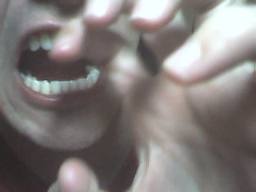
As the chorus changes from “burnin’ and lootin'” to “weapin’ and a walin’ tonight,” Kassovitz zooms in on a protest sign reading (in english) “do not forget the police kill mogador-st michel same crime same bastards.” The sign, whose aim in eliciting distrust towards police is obviously well put, also highlights what is, (in my opinion), the aim of Marley’s song and the purpose of the film La Haine. In this way Kassovitz forces the audience to not only become more involved in thinking about his film (by choosing a classic song many people enjoy), but he also forces the audience to really listen to the lyrics of the song, forcing the audience to hear the subtleties of narrative within Bob Marley’s songwriting. the first stanza of the song), the audience sees a montage of police officers affixing riot gear to their vehicles, preparing for the riot that occurs once peaceful protest is abandoned. As the song begins setting up the context in which rioting is likely to take place (e.g. I found that the song lyrics to Bob Marley’s “Burnin’ and Lootin'” were perfect for the introduction to La Haine both in their context and mood. Kassovitz uses the transition to diegetic music as a way to make the viewer much more involved with the film and foreshadow some of the film’s key events. The use of the non-diegetic music creates a distinction between the audience and the characters, as the characters are completely unaware of it. Also, the continuation “Burnin’ and Lootin’” into the actual story sets up the reasonable expectation that Saïd and his friends will find themselves in violent situations similar to those previously depicted alongside the non-diegetic version of the song.

Because the song remains the same between these two sections, the viewer is subconsciously reminded of the violence presented just before. The director drops the viewer directly into Saïd’s world, which is comprised of the same streets on which the rioters clashed with the police in the film’s introduction.

Kassovitz’ choice to transition from non-diegetic to diegetic music offers the viewer a neutral, removed look at violence in the balieue which then changes to a much more intimate study of the three teenagers involved. Saïd and the police officers across the street can hear the song bouncing off the concrete buildings in the banlieue, unlike the rioters in the opening sequence. As soon as the music becomes part of the surrounding atmosphere in which Saïd stands, it becomes diegetic. Marley’s song can still be heard, yet the music is affected to sound as though it is drifting through the air from afar. The transition to diegetic music occurs as soon as the opening credits finish rolling and Saïd opens his eyes across from several police officers. La Haine is a slow-moving film with a great deal of violence a reggae song with lyrics depicting violence parallels the entire feel of the film perfectly. This background music helps to create setting for the film because the violence in the videos is juxtaposed against a song with a very relaxed feel. The choice to use this song is interesting because its feel is anything but violent, yet the lyrics ‘we’ll be burning and looting tonight’ are certainly appropriate. During the news camera footage of the riots, the song is inherently non-diegetic because none of the characters on screen can hear or interact with the music.

The introduction to La Haine features brutal images of rioting and police brutality set to “Burnin’ and Lootin” by Bob Marley. The initial non-diegetic music provides the viewer with the context in which the film takes place and helps to set expectations for the film the transition to a diegetic version of the same song pulls the viewer into the actual plot seamlessly. The introduction to La Haine features a non-diegetic song played as a soundtrack and cuts to Saïd standing across from police in riot gear as the same song plays in the distance as a diegetic sound. Director Mathieu Kassovitz employs this method again in La Haine. For example, a song playing from a record player in a room would be a diegetic sound, whereas background music that only the audience can hear would be non-diegetic. While discussing Munich in class, we touched upon the use of diegesis as a tool to transition from one setting to another.

Diegetic sounds in film occur within the context of the film and can be heard by the characters.


 0 kommentar(er)
0 kommentar(er)
